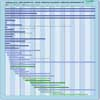| Auroral Emissions | A highly sensitive camera that collects photons radiated by auroral processes. | 3 instruments |  |
| Crustal Motion | Changes in time of the position and height of the Earth’s plates. Indicative of the lithosphere dynamics, thus useful for earthquake prediction - Physical unit: [ mm/y ] - Accuracy unit: [ mm/y ]. | 9 instruments |  |
| Crustal plates positioning | Basic for monitoring the evolution of the lithosphere dynamics - Physical unit: [ cm ] - Accuracy unit: [ cm ]. | 4 instruments |  |
| Electric Field (vector) | An instrument that measures the intensity and direction of the electric field. | 1 instrument |  |
| Electron density profile | Vertical profile of the electron density in the ionosphere and plasmasphere - Physical unit: [ electrons/m3] - Accuracy unit: [ % ]. | 6 instruments |  |
| Electron Energy and Pitch Angle Distribution | Electrons spiral around magnetic field lines, and their motion is described by their velocity along the local magnetic field and perpendicular to it. The pitch angle is derived from the ratio of those two velocities and can predict which electrons will precipitate in the ionosphere to produce the aurora and which will be reflected back along the magnetic field line. | 3 instruments |  |
| Geoid | Equipotential surface which would coincide exactly with the mean ocean surface of the Earth, if the oceans were in equilibrium, at rest, and extended through the continents (such as with very narrow channels) - Physical unit: [ cm ] - Accuracy unit: [ cm ]. | 8 instruments |  |
| Gravity field | Indicative of the statics and dynamics of the lithosphere and the mantle - Physical unit: [ mGal ] (1 Gal = 0.01 m/s2. i.e. 1 mGal ≈ 10-6 g0 . “Gal” stands for Galileo) - Accuracy unit: [ mGal ]. | 15 instruments |  |
| Gravity gradients | Gradient of the Earth’s gravity field measured at the satellite orbital height - Physical unit: [ E ] , Eötvös (1 E = 1 mGal / 10 km) - Accuracy unit: [ E ]. | 4 instruments |  |
| Ion Density, Drift Velocity, and Temperature | An instrument that measures the amount of ions encountered by the spacecraft, and attempts to deflect them to assess their velocity and temperature. | 8 instruments |  |
| Magnetic field (scalar) | [Unit of measurement – n tesla] | 7 instruments |  |
| Magnetic field (vector) | [Unit of measurement - n tesla] | 15 instruments |  |
| Neutral Particle Composition and Flow Velocity | A directional instrument that measures the amount of neutrals encountered by the spacecraft. | 2 instruments |  |
| Total electron content (TEC) | Number of electrons in between two points. Observed under more viewing angles so as to generate profiles by tomography - Physical unit: [ electrons/m2 ]; practical unit: TECU = 1016 electrons/m2 - Accuracy unit: [ % ]. | 8 instruments |  |
| ULF-HF Electromagnetic Waves | Radio receiver instrument, recording the wave received from the ground or other spacecraft, to determine how it was modified by its travel through the ionosphere. | 1 instrument |  |